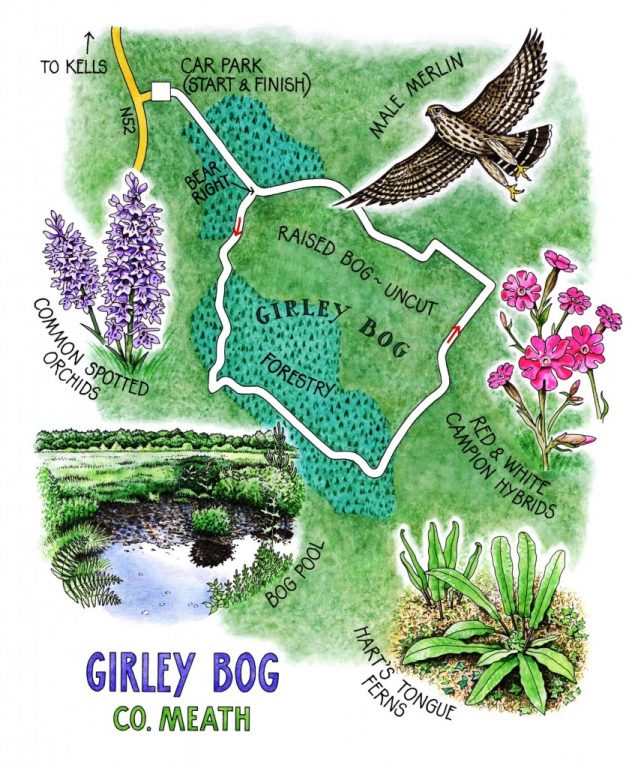Irish Independent – WALK OF THE WEEK – Christopher Somerville
1 August 2009
21. Girley Bog, Co. Meath

‘Well, I’ll be delighted to walk over Girley Bog with you,’ was Oliver Usher’s decision. ‘I’ve loved that bog all my life, and I just don’t seem to tire of being there.’
That might have been a wee bit of an understatement. Observing the Kells antique dealer as he walked the squelching tracks of Girley Bog, not only naming this flower and that, yonder bird and the one beyond that, but taking the time to admire them and puzzle over their ways and means of thriving in the ‘wet desert’ of the County Meath bogland, Jane and I were privileged to see a true enthusiast at the fountainhead of his inspiration.
Oliver was a devotee of the bog, its secret treasures of wildlife and a beauty that only gradually reveals itself, back when such a sensibility was completely unfashionable. The bog? That’s for cutting and burning, isn’t it, or bringing the potatoes on? You have to take a lot of time – a lifetime, really – to savour the bog as it should be savoured. Oliver has taken that time, and his reward has been endless interest, endless satisfaction, and a very keen desire to see his local Girley Bog, at all events, preserved from developers, road-builders, fly-tippers and all the other ‘sure-it’s-just-a-bit-of-waste-ground’ merchants.
‘The name’s not really all that clever,’ Oliver said as we started off along the rain-puddled track on a windy summer afternoon. ‘Girley, greathalloch – a marshy place. I could have thought that one up!’ The bog was certainly living up to its name today, but with boots and gaiters we kept the worst of the black splatter down at ankle level. Every ditch and drain glinted with water, and there was a constant background tinkle and trickle and occasional gurgle as if the bog itself were drinking.
There are several discrete sections to Girley Bog. The Coillte forestry lay in every stage of development from new plantings of tiny, bright green spruce and pine saplings, through half-grown plantations to the tall dark ‘corduroy battalions’ of mature forest, and then to the tumbled ground and raw sawn stumps of recently harvested blocks. In the shadows under dwarf oak boughs we walked in a crepuscular half-light. Stands of scrub woodland planted by Mother Nature, silver birch and sallow, rang with birdsong: scratchy songs of long-tailed tits, zip-zap! of chiffchaffs, the liquid ‘cut-price nightingale’ of a blackcap, the expressive baritone of a missel thrush. Then there was the ‘cutover’ or old bog, square-cut for domestic fuel, now long abandoned and feathery with multiple grasses and wide white bursts of bog cotton.
‘Now for the high bog!’ announced Oliver, leading us off the track and into a fastness of uncut, virgin bog. Girley Bog is a raised bog of thick heather and sphagnum moss, an increasingly rare environment in Ireland, feeding on rainwater rather than groundwater and slowly developing over thousands of year – perhaps ever since the end of the last Ice Age some 10,000 years ago. Out on this gently domed mass of bog, rising five or ten feet higher than the cutover, I had the sensation of being at sea, afloat on the back of a great grey wave under ecstatic lark song. We got down on our bellies and lost ourselves in a world of emerald green froglets, spotted orchids, minuscule lichens with scarlet heads like matchsticks, golden rods of bog asphodel and sundews engulfing motionless flies.
Among all these subtle, unemphatic delights, the one dramatic moment of the walk saved itself until last. As we were driving off, heading down the bog track to the Kells road, we noticed a tremendous commotion up ahead, an explosion of frantic energy and movement on the ground. Oliver cut the van’s engine and we coasted up to the spot.
It was a magnificent male merlin, small and slate-backed, at death grips with a female blackbird almost his size. They rolled across the track almost under our wheels and fell into a bog drain, utterly intent on each other, the blackbird squawking desperately, the merlin clenching her breast in his talons and flapping his barred wings. Only when we got out of the van did the tiny hawk let go and fly off, leaving his victim exhausted and motionless in the ditch. It was a moment to remind us, if we needed reminding, of the natural world’s never-ceasing redness in tooth and claw.
WAY TO GO
MAP: OS of Ireland 1:50,000 Discovery 42; downloadable map/instructions (highly recommended) at www.discoverireland.ie/walking.
TRAVEL:
Bus (www.buseireann.ie): Services 108, 109 to Kells
Road: From Kells, N52 towards Mullingar. After 4 miles, brown ‘Trailhead’ sign on left; gravelled track leads to car park (OSI ref N 695711)
WALK DIRECTIONS: Follow purple arrows (PA) along gravelled track to crossroads; right (PA) along bog path, following PA to make an anti-clockwise circuit of the bog.
LENGTH: 4 miles: allow 2 hours
GRADE: Easy
CONDITIONS: Paths can be very squelchy, especially after rain; wear good waterproof boots.
DON’T MISS … !
• subtle beauty of the uncut bog: birdsong, frogs, sundews, silence …
• tiny lichens, branched or scarlet-tipped – bring a magnifying glass
• wild food along the way: frochans, wild raspberries, blackberries
REFRESHMENTS: Picnic (and wild food!)
ACCOMMODATION: Headford Arms Hotel, Kells (0818-222-800; www.headfortarms.ie)
INFORMATION: Walking tour operators, local walks including Discover Ireland’s National Loop Walks, walking festivals throughout Ireland: www.discoverireland.ie/walking; www.coillteoutdoors.ie
INFORMATION:
Tourist Office: Castle Street, Trim (046-943-7227; www.meath.ie/tourism)
csomerville@independent.ie